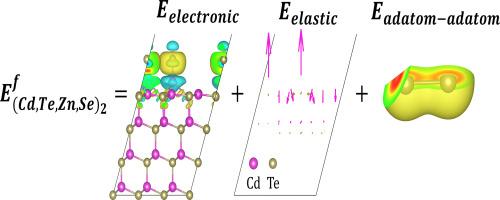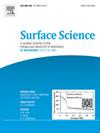CdTe(111)表面吸附物与Cd、Te、Zn和Se原子相互作用的第一性原理研究
IF 1.8
4区 化学
Q3 CHEMISTRY, PHYSICAL
引用次数: 0
摘要
吸附物-吸附物相互作用的研究对于理解早期晶体生长动力学至关重要。我们利用平面波密度泛函理论研究了Cd-Cd、Te-Te、Zn-Zn、Se-Se、Cd-Te、Cd-Se、Cd-Se、Te-Se、Te-Zn和Se-Zn两种CdTe(111)表面上的二元配原子对之间的相互作用。对二元附原子对相互作用能的分析表明,无论附原子之间的相对距离如何,排斥相互作用都是常见的。对于CdTe(111)A表面,相邻的硫原子(即Te和Se)和第12族(即Cd和Zn)配原子对之间发生吸引相互作用。对于CdTe(111)B表面,相邻的12族配原子之间发生吸引相互作用,形成表面二聚体构型。此外,结合原子对的形成能被分解为电子、弹性和结合的贡献。对于附着原子之间较小的原子间距离,形成能主要是电子相互作用的函数,对于含有第12基团的对,弹性和附着原子结合相互作用的贡献为零。由于吸附原子之间的原子间距离越大,电子相互作用越不利,形成能通常越正。最后,相对于单吸附原子,CdTe(111)A表面上从顶部到fcc和从fcc到fcc的迁移障碍显著增加,而CdTe(111)B表面上的迁移障碍仅在氯化物从fcc到fcc的迁移中增加。从这一分析中,我们说明了在CdTe(111)薄膜表面成核过程的早期阶段,配原子相互作用的作用。本文章由计算机程序翻译,如有差异,请以英文原文为准。

A first principles study on the adsorbate-adsorbate interactions on the CdTe(111) surface with Cd, Te, Zn, and Se adatoms
The study of adsorbate-adsorbate interactions is essential to understanding early crystal growth dynamics. We employ planewave density functional theory to study the binary adatom pair interactions between Cd-Cd, Te-Te, Zn-Zn, Se-Se, Cd-Te, Cd-Se, Cd-Zn, Te-Se, Te-Zn, and Se-Zn adatom pairs on two CdTe(111) surfaces. An analysis of the interaction energies between binary adatom pairs suggests repulsive interactions are common regardless of the relative distance between adatoms. For the CdTe(111)A surface, attractive interactions occur between neighboring chalcogen (i.e., Te and Se) and Group 12 (i.e., Cd and Zn) adatom pairs. For the CdTe(111)B surface, attractive interactions occur between neighboring Group 12 adatoms forming a surface dimer configuration. Furthermore, the formation energy of an adatom pair is decomposed in terms of the electronic, elastic, and adatom binding contributions. For smaller interatomic distances between the adatoms, the formation energy is primarily a function of the electronic interactions, with null contributions from the elastic and adatom binding interactions for Group 12-containing pairs. Because of the less favorable electronic interactions for larger interatomic distances between the adatoms, the formation energies are typically more positive. Lastly, neighboring adatoms significantly increase the barriers of migration on the CdTe(111)A surface relative to unary adatoms for the top-to-fcc and fcc-to-fcc sites, while the migration barriers on the CdTe(111)B surface only increases for the fcc-to-fcc migration of chalcogen species. From this analysis, we illustrate the role of adatom interactions during the early stages of the surface nucleation processes on CdTe(111) thin films.
求助全文
通过发布文献求助,成功后即可免费获取论文全文。
去求助
来源期刊

Surface Science
化学-物理:凝聚态物理
CiteScore
3.30
自引率
5.30%
发文量
137
审稿时长
25 days
期刊介绍:
Surface Science is devoted to elucidating the fundamental aspects of chemistry and physics occurring at a wide range of surfaces and interfaces and to disseminating this knowledge fast. The journal welcomes a broad spectrum of topics, including but not limited to:
• model systems (e.g. in Ultra High Vacuum) under well-controlled reactive conditions
• nanoscale science and engineering, including manipulation of matter at the atomic/molecular scale and assembly phenomena
• reactivity of surfaces as related to various applied areas including heterogeneous catalysis, chemistry at electrified interfaces, and semiconductors functionalization
• phenomena at interfaces relevant to energy storage and conversion, and fuels production and utilization
• surface reactivity for environmental protection and pollution remediation
• interactions at surfaces of soft matter, including polymers and biomaterials.
Both experimental and theoretical work, including modeling, is within the scope of the journal. Work published in Surface Science reaches a wide readership, from chemistry and physics to biology and materials science and engineering, providing an excellent forum for cross-fertilization of ideas and broad dissemination of scientific discoveries.
 求助内容:
求助内容: 应助结果提醒方式:
应助结果提醒方式:


